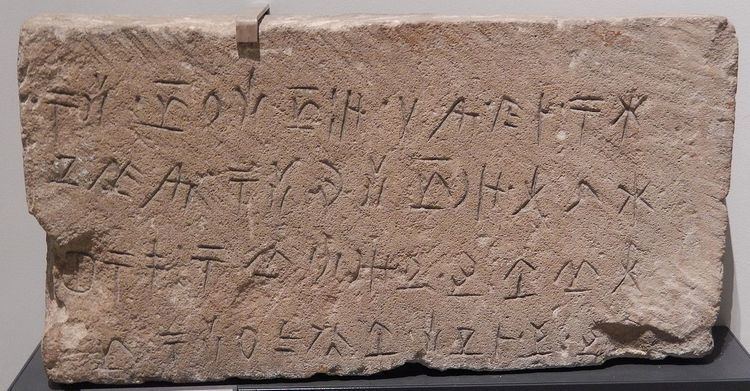Era 10th to 4th century BC Writing system Cypriot syllabary | ISO 639-3 ecy | |
 | ||
Native to Formerly spoken in Cyprus Region Eastern Mediterranean Sea | ||
Eteocypriot was a pre-Indo-European language spoken in Iron Age Cyprus. The name means "true" or "original Cyprian" parallel to Eteocretan, both of which names are used by modern scholarship to mean the pre-Greek languages of those places. Eteocypriot was written in the Cypriot syllabary, a syllabic script derived from Linear A (via the Cypro-Minoan variant Linear C). The language was under pressure from Arcadocypriot Greek from about the 10th century BC and finally became extinct in about the 4th century BC.
Contents
The language is as yet unknown except for a small vocabulary attested in bilingual inscriptions. Such topics as syntax and possible inflection or agglutination remain a mystery. Partial translations depend to a large extent on the language or language group assumed by the translator, but there is no consistency. It is conjectured by some linguists to be related to the Etruscan and Lemnian languages, and by others to be Northwest Semitic. Those who do not advocate any of those theories often adopt the default of an unknown pre-Greek language. Due to the small number of texts found, there is currently much unproven speculation.
Corpus
Several hundred inscriptions written in the Cypriot syllabary (VI-III BC) cannot be interpreted in Greek. While it does not necessarily imply that all of them are non-Greek, there are at least two locations where multiple inscriptions with clearly non-Greek content were found:
While the language of Cypro-Minoan inscriptions is often supposed to be the same as (or ancestral to) Eteocypriot, that has yet to be proved, as the script is only partly legible.
Amathus bilingual
The most famous Eteocypriot inscription is a bilingual text inscribed on a black marble slab found on the acropolis of Amathus about 1913, dated to around 600 BC and written in both the Attic dialect of Ancient Greek and Eteocypriot. The Eteocypriot text in Cypriot characters runs right to left; the Greek text in all capital Greek letters, left to right. The following are the syllabic values of the symbols of the Eteocypriot text (left to right) and the Greek text as is:
Eteocypriot:A suggested pronunciation is:Greek:which might be rendered into modern script as:A suggested translation is:Cyrus Gordon translates this text as
Gordon's translation is based on Greek inscriptions in general and the fact that "the noble Ariston" is in the accusative case, implying a transitive verb. Gordon explains that "the verb is omitted ... in such dedicatory inscriptions". The grammar of the Greek, however, is not necessarily that of the Eteocypriot.
The inscription is important as verifying that the symbols of the unknown language, in fact, have about the same phonetic values as they do when they are used to represent Greek. Gordon says, "This bilingual proves that the signs in Eteocypriot texts have the same values as in the Cypriot Greek texts...." However, as a bilingual it uses only a few Greek syllables to translate many Eteocypriot ones, which adds to its mystery.
